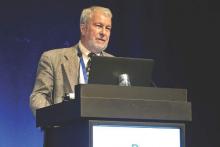STOCKHOLM – PEGylated insulin lispro (PEGlispro) lowered hemoglobin A1c to a greater extent than did insulin glargine in patients with either type 1 or type 2 diabetes mellitus and offered several potential advantages and disadvantage as a basal insulin, judging from results of several trials and analyses, some presented for the first time at the annual meeting of the European Association for the Study of Diabetes.
Data from the phase III, randomized, double-blind IMAGINE 2 trial, for example, showed that in patients with type 2 diabetes treated with oral antidiabetic drugs and who were insulin naive, PEGlispro produced superior reductions in HbA1c when compared directly with insulin glargine. At 1 year of follow-up, the mean change from baseline in HbA1c was –1.56% for PEGlispro-treated (n = 1,003) and –1.27% for glargine-treated (n = 535) patients, representing a statistically significant –0.29% (P less than .001) difference between the two insulins.
Dr. Melanie Davies of the University of Leicester (England) Diabetes Research Centre, who reported the IMAGINE 2 findings said that significantly more PEGlispro- than glargine-treated patients achieved a target HbA1c of less than 7% (57.6% vs. 42.8%; P less than .001) or 6.5% or lower (36% vs. 24%; P less than .001) at 1 year. Importantly, “BIL [basal insulin PEGlispro] resulted in greater reduction in HbA1c with less glycemic variability,” Dr. Davies observed.
While there was no significant differences in the rates of total or serve hypoglycemia between the groups, there were fewer instances of nocturnal hypoglycemia, she said, with an event rate per 30 days of 0.3 vs. 0.4, and overall incidences of 60% and 40% (P less than .001). Patients treated with PEGlispro also experienced less weight gain (+2.1 kg vs. +2.6 kg; P less than .001).
PEGlispro is essentially insulin lispro that has been modified by adding a polyethylene glycol chain. This adaption makes it a larger molecule and results in a half-life of around 2-3 days and a duration of action of 36 hours or more.
Asked in an interview why another basal insulin was needed, Dr. Clifford J. Baileyof Aston University in Birmingham, England, responded: “I suppose the same question was asked when we had NPH [insulin], why would we want a longer-acting insulin?”
Dr. Bailey, who cochaired the sessions in which the IMAGINE 2 findings were presented and who was not involved in the trial, added: “The longer and longer the [duration of] action of insulin, with a flatter [glycemic] profile, the greater the likelihood is that one can control the glucose level to be more consistent with the [normal] physiological delivery of insulin.” Together with improving the way in which insulin is delivered, there may also be the potential for dosing every other day, weekly, or even monthly, he suggested.
The safety profile of longer-acting insulins is something “that may need ironing out,” he acknowledged, which might be addressed by again making a small alteration in the molecule or reducing the size of polyethylene glycol chain, for example.
The effects of PEGlispro appear just as good in patients with type 1 diabetes, according to the findings of the phase II IMAGINE I trial that were also presented at the EASD meeting. This open-label study comprised 455 patients and found those treated with PEGlispro had significantly lower HbA1c (7% vs. 7.4%) at 26 weeks’ follow-up. Again there were fewer episodes of nocturnal hypoglycemia and a weight reduction benefit with PEGlispro. Results from the phase III IMAGINE 3 study were presented as a poster and showed similar beneficial findings on glycemic control.In terms of safety, patients treated with PEGlispro in these IMAGINE trials generally experienced an increase in triglycerides and alanine aminotransferase when compared with glargine, and liver fat was higher in the PEGlispro- than in glargine-treated patients. In a subset of patients who underwent MRI of the liver in IMAGINE 2, liver fat was unchanged from baseline, whereas there was a decrease seen with glargine. In IMAGINE 1 a slight increase in liver fat was seen with PEGlispro.
Dr. Byron Hoogwerf of Eli Lilly presented data on lipid changes seen during 26 weeks of treatment in six phase III IMAGINE trials – four of which were performed in patients with type 2 diabetes. These data had previously been aired at the American Diabetes Association annual scientific sessions, he said, and considered a total of 5,583 randomized patients, 2,179 of whom had type 2 diabetes, were insulin naive, had been treated with basal insulin only; a further 1,835 type 2 patients who had previously been treated with insulin who received either basal only or basal-bolus dosing; and 1,569 patients with type 2 diabetes. In most of the trials, PEGlispro was compared against glargine, but in one of the trials, NPH was used.



